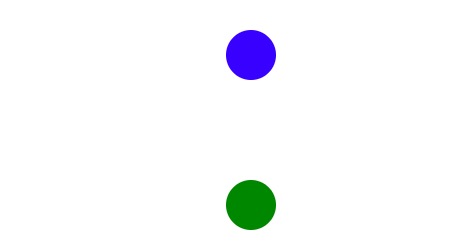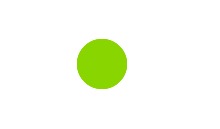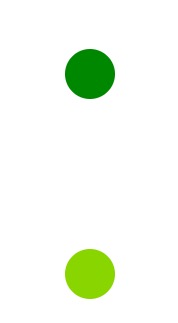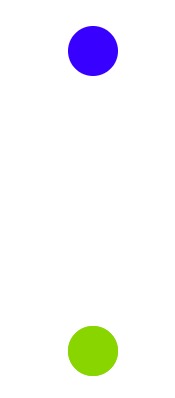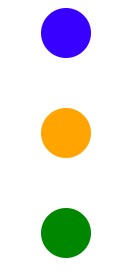这里讲解d3的 enter update exit三种模式,以及 append、data、selectAll。
基本代码
下面代码都基于以下代码:1
2
3
4var svg = d3.select("body")
.append('svg')
.attr('width', 800)
.attr('height', 800);
以上是d3常用写法,下面示例皆以此为基础展开:
append
单个使用
1 | var new_circle = svg.append('circle') |
多个使用
1 | svg.append('circle') |
小结
由上可知append其实就是用来添加实际效果的。
selectAll
在上面《append》的代码上增加:
1 | var new_circle = svg.selectAll('circle') |
示例二
在基本代码上增加如下代码
1 | svg.append('circle') |
增加selectAll后:
1 | svg.selectAll('circle') |
小结
上面的例子都是单独使用selectAll,没有使用data(),此时selectAll选中所有的匹配,进行update,此时selectAll就是一个选择器,对selectAll进行链式操作,可将所有被命中的改写(可称之为update)
data()
在基本代码上,增加如下代码:
1 | svg.append('circle') |
修改data数组 length=1
修改以上代码中的1
var data = [10];
修改data数组 length=0
修改以上代码中的1
var data = [];
selectAll 与 data 的关系
由上可知,selectAll 是一次性命中了所有,如果要对这所有对命中进行过滤等操作,就使用data();
且经过data()操作后,就拥有了enter或exit操作方法,当然你可以不使用这些方法。
因此说白了,enter和exit无非是data()\selectAll()选择数据能力的延伸。
selectAll data enter exit 的联系
参考《selectAll 与 data 的关系》,selectAll data enter exit都是数据的采集命中匹配。
enter
基本用法
enter 匹配 数据大于已存在时。1
2
3
4
5
6
7
8
9
10
11
12
13
14 var svg = d3.select("body")
.append('svg')
.attr('width', 800)
.attr('height', 800);
var data = [10];
svg.selectAll('circle')
.data(data)
.enter()
.append('circle')
.attr('cx', 250)
.attr('cy', 350)
.attr('r', 25)
.attr('fill', 'yellowgreen')
enter()要与append搭配使用
见上面《基本用法》
enter 不会 改变已存在的
1 | var new_circle = svg.append('circle') |
比较好的exitdemo
- demo 1,此demo是一个简单散点图,其中的去掉图中散点功能非常棒。
exit
不使用exit
在上面代码上增加:1
2
3
4
5
6
7
8
9
10
11
12
13
14
15svg.append('circle')
.attr('cx', 250)
.attr('cy', 50)
.attr('r', 25)
.attr('fill', 'blue')
svg.append('circle')
.attr('cx', 250)
.attr('cy', 150)
.attr('r', 25)
.attr('fill', 'green')
svg.append('circle')
.attr('cx', 250)
.attr('cy', 250)
.attr('r', 25)
.attr('fill', 'orange')
使用exit
在上面代码上加入以下代码
1 | var data = [10]; |
exit不与append一起使用
使用《使用exit》代码中,注释的部分解注,效果将是: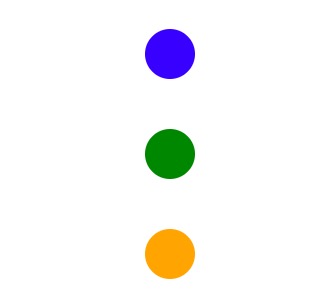
此时exit没有任何作用。
exit将会改变已存在的
参考《使用exit》
update
示例一
1 | var svg = d3.select("body") |
示例二
1 | <p>default</p> |
update = p.data(arr)
比如示例二可写成:1
2
3
4
5var data = [10, 20, 30];
var update = d3.selectAll('p');
update.data(data)
.text(t=>t)
因此可认为 update 等于 data()方法的修改。
小结
通过上面例子,update实际上是元素与数据绑定时,元素与数据 的交集部分的更新。
这种情况少。
大话各者之间关系
选择集 - select selectAll
数据绑定 - selection.data()
数据绑定的选择集 - enter exit
DOM操作 - attr append insert
远程加载数据 d3.josn()
应用demo
柱状图demo
此demo非常简短,对enter update exit理解非常有帮助。



